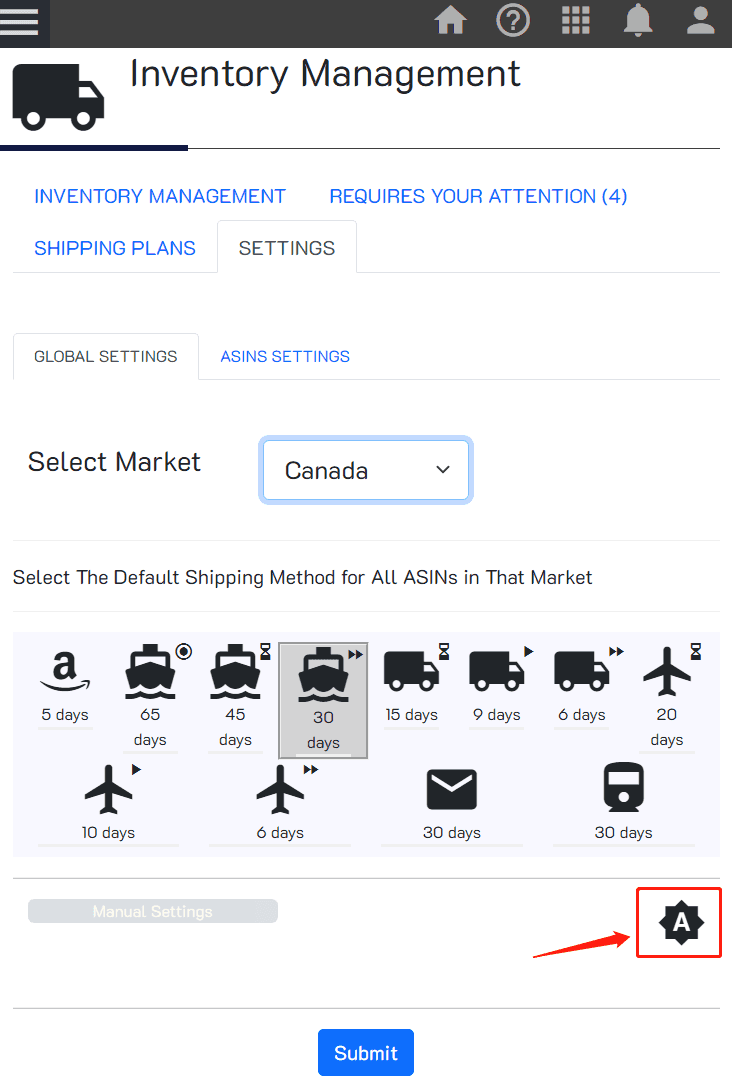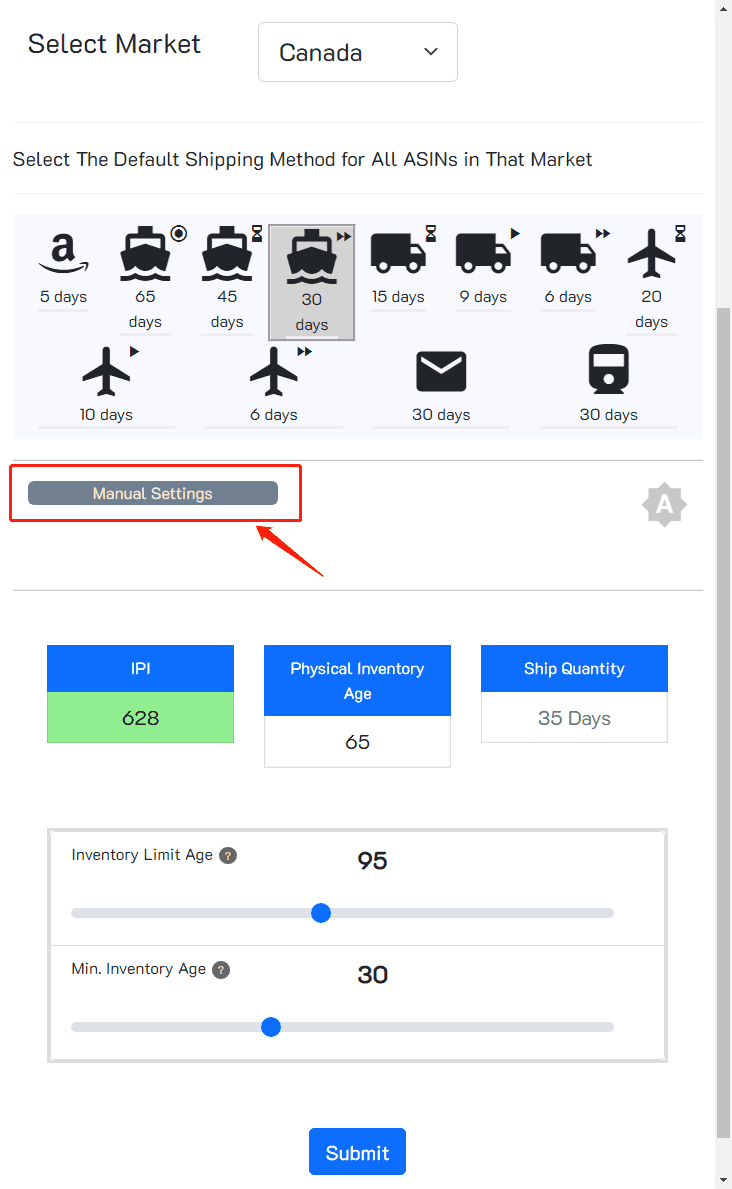Global Inventory Settings
The Manage Inventory Settings page lets you customize parameters that control your inventory operation.
There are 2 ways to keep inventory in line with Amazon IPI:
Global Settings
Automated:
Using the Automated method, you will only need to define what shipping method you use to ship your inventory to Amazon fulfillment centers, and to which market.

The automated method uses your sales data to manage your inventory and at the same time keeps your IPI score within acceptable levels. but it might not work if Amazon imposes an ASIN level limit, at this point, you need to manually configure each market parameters.
Manual Configuration:
You will have to define 2 parameters to stabilize your inventory management process.
Amazon Maximum Inventory Age
The Maximum Amazon Inventory Age which is measured in days is your inventory limit per ASIN in which you define how many maximum days can your physical inventory, any inventory that is on the way, and any shipping plan that was made can all be accumulated to set the ASIN limit.
Minimum Amazon Inventory Age
The Minimum Amazon Inventory Age is where the system will make sure that your physical inventory age located at amazon fulfillment centers does not fall below this value, meaning, if your minimum inventory age is 40, the system will make sure that you will always have 40 days of supply in amazon warehouse. It does this by alerting you to send inventory when your current inventory age is at this value plus your shipping method period and the fulfillment period, i.e., if your shipping time is 15 days and your fulfillment period was 5 days, then it will alert you to send a new shipment when your physical inventory will last 60 days.

Using these 2 paramours, the system will find out how many units you will need to ship every time. This value must be watched carefully, as the more you ship to amazon the less your IPI score will be, typically amazon suggests below 2.25 months of inventory to be sent each time, you can adjust this value, if you want to decrease how many units to be shipped, you can decrease the Maximum Amazon inventory age, or Increase the Minimum Inventory age, and if you want to increase it, you can Increase Maximum Amazon inventory age and decrease the Minimum Inventory age.
Here is an example:
Imagine that you use Sea Freight to ship your goods from overseas and it takes 45 days to arrive, From the shipment methods, you will pick Sea Slow.
Now adjust the parameters to :
Maximum inventory age: 105
Minimum Inventory age: 55
Your IPI score will look bad, that’s because the system will keep trying to keep 55 days of inventory always, and in order to do this, it will ask you to ship 50 days of supply when your inventory age falls below the 55 minimum inventory age + 45 days shipping time, this means that at some point you will have (55+45) 100 days of supply and amazon will not like that.
In order to adjust the values, Let's say we want to keep at least 30 days of supply (depending on your ASIN) in Amazon warehouse, then to keep our IPI score reasonable, we set a maximum inventory age to 95.
So, with the above example, assume the following (please refer to the picture above):
Today is 1/1/2022, and we have 40 days of supply at Amazon warehouse and another shipment that has not arrived yet which have a supply of 35 days. Our total supply is both physical inventory and any shipping plan that was made which is 40 + 35 = 75 Days.
The system will wait until our Total supply falls below our Minimum Inventory Age + Shipping Time 30 + 30 = 60 days and it will alert us to ship 35 units.
On 1/15/2022 assuming our sales are still steady, The total supply now is 60 Days (75 - 15), so the system will trigger to ship a new 35 days of supply, and after creating the shipping plan, our total supply will be 60 + 35 = 95 which is what we defined as Maximum Inventory Age.
Important Notes:
When you adjust these parameters, you have to keep in mind the following:
1. Depending on how fast your ASIN sells, you should keep at least 25-45 days of stock always in Amazon warehouse, that’s because amazon spread your inventory among hundreds of fulfillment centers, and if your quantity is low, some fulfillment centers would be out of stock which causes that some customers will face longer delivery time, and because of that you might lose to your competitors or you might lose the buy box.
2. You should keep your IPI score above 500, Amazon will block your sending privilege if your IPI falls below 450. (Sometimes 500).
3. Depending on your suppliers and inventory availability, the best strategy is to send multiple smaller shipments instead of one big shipment. This will keep your fees and risk low.
4. When amazon enforces stock limits, it’s enforced on the physical and virtual inventory, which is any stock available, any returns, and shipment on the way and any plan made and was not shipped yet, in this case, you need to readjust the levels by lowering the virtual inventory to match with whatever amazon enforces.